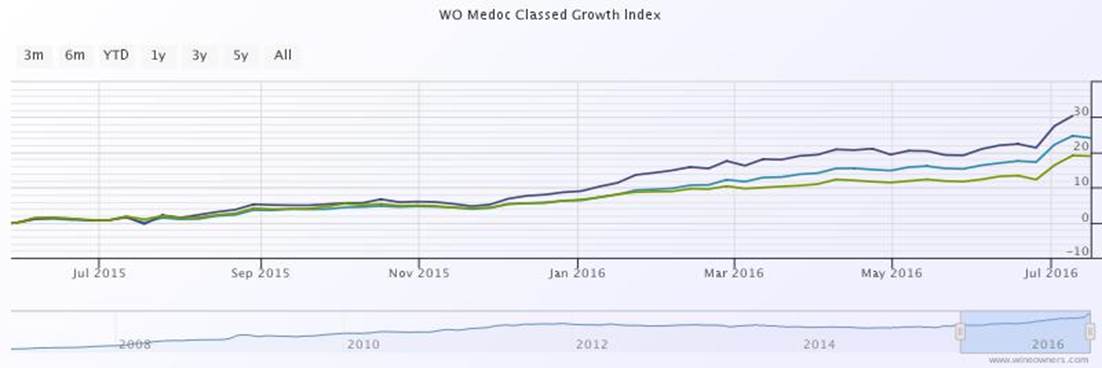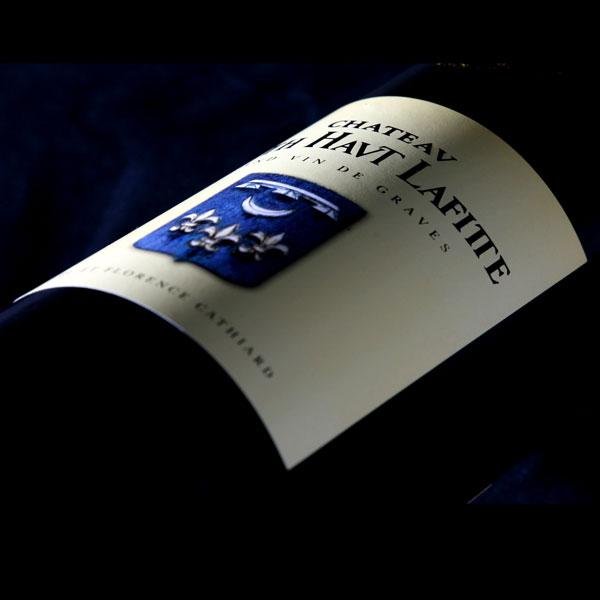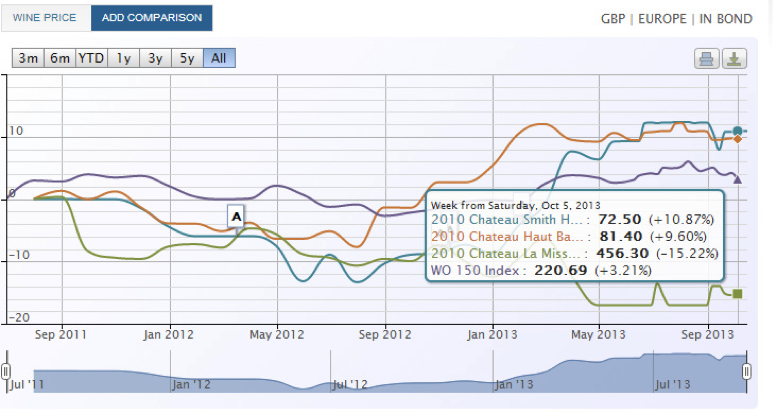by Wine Owners
Posted on 2018-10-17
When tasted from barrel in the spring of 2017, it was very evident that this was a vintage with loads of extract, with one of the highest ever IPT levels ever recorded in Bordeaux. IPT is a measure of the combined phenolic compounds in the juice - principally tannins and colorants responsible for the red, purple and blue hues in grapes. Large bunches of rather small berries meant high skin to juice ratios.
We suspected that the finest wines were those who extractions were gentle - neatly summarised by Frédéric Faye at Chateau Figeac who described their fermentation process as an ‘infusion’ with the gentlest of extractions achieved from the submerged cap.
With the proviso that the 2016s have been in bottle for as little as 3 months, this was an opportunity to re-taste a selection and test our original impressions from 18 months ago.
The more extracted wines with highest IPT levels were evident, and at this stage it has to be said that they were the least harmonious. Where there was a desire to make full use of, or to accentuate, all the elements proffered by nature, the palate tended to be dominated by raw power, the scale undeniable but at the expense of charm for now.
The structure of 2016, hidden under a cloak of velvety fruit and sweet tannins when barrel samples, was much more evident now the wines are in bottle, and this structure allied to tremendously aromatic fruit in the best examples, affirms 2016 as a vintage with some truly great wines in the making.
It’s not just a great cabernet sauvignon vintage either, with some of the right bank merlots absolutely stunning. La Conseillante that had seemed a little sweet and svelte at the property in April 2017 is now brilliantly pitched, with extremely expressive and aromatic fruit held in check by an impressive frame of tannins.
What was slightly surprising however, was the wide variation. Those who are tempted to categorise 2016 as a uniformly great vintage will be disappointed; there is plenty of dull wine. The difference between the vintage's heights and the good average is a chasm.
The Northern Medoc had an especially successful vintage, with Cantermerle showing excellent concentration and focus, and my pick of the appellation at en primeur, Citran, showing all of its former promise and more. Could this be the bargain of the vintage?
Domaine de Chevalier has made an epic red, with great substance and lovely resonance, and on this showing had the better of the high-in-cabernet-franc Carmes Haut-Brion. Though evidently fine fruited, Haut Bailly’s firm tannins are a bit overwhelming for now. Both Pape Clement and Smith Haut Lafitte major on great substance and scale, but show a raw or unknit character at this early stage.
Canon was showing very defined fruit with loads of grip but for now felt very slightly loose on the finish. Figeac has managed to combine stunning definition, texture, harmony and length and on this showing must be a 100 point wine in the making.
Gazin was absolutely charming with an impressively solid core. La Conseillante as already mentioned was a hit.
St Estephe and Pauillac were as good as expected given how fine the Cabernet was from this upper part of the Medoc peninsular, and wines from Cos Labory and Phelan Segur were notably excellent at their price levels.
Clerc Milon had stood out as exceptional in April 2017, and now in bottle shows impressive density, a huge finish and attractive gaminess. D’Armailhac was extremely exciting, packed with red fruit and finely beaded acidity and plenty of accompanying structure. Pichon Longueville Comtesse was one of the stars of the en primeur tasting and once again stood out for its super-refinement: unquestionably a top wine of the vintage.
In St Julien the Bartons stood out. Langoa was svelte, intense, showed gorgeous scale and definition at a very attractive price point. Leoville Barton was another league and heads above the other St Juliens. Huge, but super fresh, light-footed, with a mouthwatering blood orange infused core and a very direct, linear finish. One of the greatest wines of the vintage.
Lagrange was fine, the tannins so ripe and silky that their velvety texture cloak its underlying structure, just as it did when tasted in London a year ago. Talbot was back to it’s very best, likely up there with its beautifully balanced 1982.
The Margaux appellation in the main was not quite as exciting as the magnificent 2015s, a vintage in which the commune excelled. However one stood out for it’s stunning definition and extraordinary elegance. A fitting wine to finish this round-up of 2016s in bottle. Beautifully textured. A wine that simply flows across the palate with effortless grace. It helps that it’s also one of the most under-rated wines in the whole of Bordeaux, sitting as it does on great terroir. The wine in question is Chateau Dufort-Vivens, Second Growth Margaux, fully biodynamic, and an outstanding success in 2016.
by Wine Owners
Posted on 2017-05-11
The tasting event in Westminster for the trade in early May provided an opportunity to re-taste a number of 2016 Bordeaux comparatively with their 2015 and 2014 equivalents.
The conclusions reinforce to a large extent the general impressions we formed in Bordeaux at the start of April, but the comparison also showed it’s not one size fits all.
Canon
Starting with the one wine tasted from the right bank, Canon 2016 is showing more aromatics than 2015, very silky, integrated tannins and is thicker-styled, with riper fruit. Canon 2015 showed greater intensity, with a stunningly pure mid-palate of ripe, sticky fruit, and a prolonged finish. Canon 2014 is more classically styled, with a cedar nose and liqueur-like mouth feel, this is lovely now and looks like much earlier drinking.
No doubt there are glorious wines from the Libournais in 2016, but both St Emillion and Pomerol do not conform to a vintage stereotype in these two vintages, and you will have preferences for individual wines from one or other year.
Smith Haut Lafitte
Jumping down to Pessac-Léognan, Smith Haut Lafitte (SML) 2016 is firm and properly dry, with crystalline fruit. Very intense and just on the right side of focus, with a very grippy, licorice finish. SML 2015 has a very energetic attack, sweet, refined tannins, a warm, fruity mid-palate and an aromatically spiced finish. SML 2014 was delicious but not in the same league as the other two vintages.
2015 was a stellar vintage in Pessac and Graves across the board. The same is not true of 2016 but SML showed (along with Haut Bailly, Chevalier and Carmes Haut Brion) that the best 16s are superlative and brilliantly architected for the long-term.
Rauzan Ségla
Rauzan Ségla 2016 is refined, with a liqueur-like mouth feel, and a hint of prunes. It’s less pure than Rauzan-Ségla 2015, with its fine nose, superbly energetic attack, refined mid palate and liquorice infused, fruit-driven finish. Rauzan-Ségla 2014 is dry, mid-weight, unforced and classic, with appealing grip, and a great, insistent finish.
Margaux was a star appellation of 2015, and this wine confirms how relatively disappointing the commune'’s wines are in 2016. They remain fine claret from a good vintage, but they miss out on the excitement of the ‘15s.
Pontet Canet
Our Pauillac representative of the comparative tasting stood out for its increasingly aromatic character, a factor that Justine Tesseron attributes to the growing influence that biodynamic farming is having on the fruit.
Pontet Canet 2015 was one of the most refined and silky examples of the appellation, yet today it just didn't cut it in the company of the glorious 2014 and deeply serious 2016. Pontet Canet 2016 displayed a fine nose, wonderfully textured fruit, a really firm mid-palate with bitter-edged fruit before sweetening into the long finish. Serious, long-haul stuff – and I suspect might become a legend 50 years hence. Pontet Canet 2014 is extremely aromatic, sweetly imbued with angelica flavouring, and with proper, grainy tannins on the finish.
Montrose
Montrose 2015 is delicious and aromatic: a fine showing for the vintage, yet seemed to lack a bit of structure. St Estephe in particular produced some of the best wines in a generation in 2016, and Montrose shows up that difference as does almost every wine from the appellation. Montrose 2016 is equally as expressive as 2015, but feels like a wine for the longer term, with more serious structure and vital freshness. What impresses here is the focus and elegance, which make this one of the stars of the vintage.
Picture: Wine Owners Ltd.
by Wine Owners
Posted on 2016-07-25
It is fair to say that in the recent improvement of fortunes in Bordeaux prices, most focus is given to the classed growths of the Medoc on the Left Bank, and the top wines of Pomerol and St Emilion on the Right Bank. The recovery over the last 12 months has been significant, as seen below, with the Medoc Classed Growth Index (the turquoise line) rising by over 23% and the Libournais Index (purple line) up over 18%. Great news for all those people who have experienced the huge price correction of 2011 to 2014.
But, when looking at Bordeaux as a whole the focus should perhaps swing further south. See what happens when I add the Graves Classed Growth Index (the purple line in the chart, below) into the mix. Over the same time frame the wines of Graves, headlined by Haut Brion and la Mission Haut-Brion, have leapt up by over 30%, outstripping their neighbouring appelations.
Even when you take into account the Brexit effect, which has seen a weak pound in the past month provide a boost from sterling denominated stock as HK and US buyers pile in, this still represents a huge return to form. The lesson here is to realise that the 1855 classification (which ignores Graves, with the notable exception of Haut-Brion) and finest wines north of the Garonne are not the be all and end all. Look south, towards Graves, and you will find a raft of excellent wines that have improved dramatically in the last few years in many instances (think Smith Haut Lafitte, Haut-Bailly, Pape Clement), and which represent both great quality and great value. It is perhaps important that the gravelly, smoky, pencil lead and pencil shaving notes which characterise the best wines of Graves have few, if any, imitations around the world. Bordeaux blends from other continents tend to mimic the Medoc or the Libourne, and so the terroir-specific nature of Graves wines perhaps gives them a uniqueness that collectors ascribe value to in the same way as they do in Burgundy.

Sometimes it pays to take the path less travelled….
by Wine Owners
Posted on 2013-10-18

Comparing the 2009 and 2010 vintages of the overachieving Chateau Smith Haut Lafitte shows how vintage styles can make a huge difference to market value. The massive and opulent 2009, which wins a perfect score from Robert Parker, is by no means a huge qualitative improvement on the slightly lower rated 2010. In fact, as we’ll see, plenty of reviewers prefer the 2010.
The obvious feature of the price comparison below is that the market price of the 2009 with its 100 point rating from Robert Parker has risen by well in excess of 100%, while the 2010, which gained a few points on its initial rating (95-97, rerated to 98+), has remained steady at close to release price.

One point to take away is that a very good re-rating is not enough to take a price higher in the current market unless it is a perfect rating. While this may be disappointing for those who bought 2010 and not 2009, it does mean the 2010 is considerably less expensive to buy now, in what is a relatively low market. Considering Neal Martin, Wine Enthusiast and Jancis Robinson all rate the 2010 higher than the 2009, albeit marginally, it certainly seems the better buy of the two vintages with a market value of £870 against 2009’s £1,487. For a price conscious buyer, the prospect of spending almost double for an extra 2 Parker points might seem hard to swallow, so unless the particular style of the 2009 appeals very strongly, the 2010 feels more like a reasonable price for a wine of that quality.
|
2009 |
2010 |
| Robert Parker |
100 |
98+ |
| Neal Martin |
94 |
95 |
| James Suckling |
96 |
95 |
| Jancis Robinson |
17.5 |
18 |
| Wine Enthusiast |
94 |
96 |
| Wine Spectator |
96 |
96 |
| Wine Owners |
95 |
94 |
How does it look in comparison to other comparable wines? Similar scores in Pessac were achieved by Haut Bailly (98 RP) and La Mission Haut Brion (98+):

Haut Bailly has put on a similar amount of weight, but is still quite a bit more expensive to buy at around £80 per bottle. Both wines have outperformed the Wine Owners 150 Index, showing an encouraging ability to hold value in a difficult market. Honorary First Growth La Mission Haut-Brion, on the other hand, has behaved just as one would expect of a top flight wine that didn’t quite make the perfect score, slipping steadily downwards to 15% below the ambitious release price. At around £5400 per dozen, it makes the other two look like good finds.
Perhaps the most interesting thing to note here, though, is the huge influence that Wine Advocate scores continue to exert on market prices, particularly in Bordeaux. With Parker’s sale of his stake in WA, and the high profile departure of influential critics like Jay Miller and Antonio Galloni, many might like to think that the journals days as a key market influencer are numbered. Commentary abounds about the future of wine criticism, whether the future lies in collaborative reviewing along the model of Cellar Tracker, aggregate scoring, or whether a new super-critic will emerge to take Parker’s place. The numbers, however, tell a different story, and testify strongly to the market’s desire for a reference point.
2010 Smith Haut Lafitte is available on the Fine Wine Exchange at £820 IB

